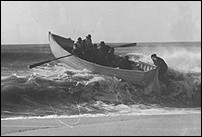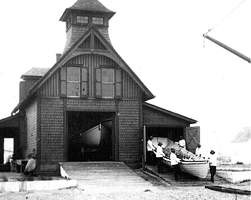How Lifesaving Came to Port Orford
The earliest recorded efforts to prevent shipwrecks and provide lifesaving services go back as far as 300 BC with the construction of the massive lighthouse at R’as Al-Tin in Alexandria, Egypt. In 46 BC, the Romans enacted laws that required assistance be rendered to sailors in distress and victims of shipwrecks.
King Richard III of England sought to protect shipwreck victims by decreeing that anyone found guilty of taking advantage of shipwrecked seamen “shall forfeit their possessions, be tied to a post in the center of their home, and the house be burned.”
Chinese lifesaving services documented as early as 1708, albeit with a different approach. Rather than imposing penalties for not rendering assistance or taking advantage of the situation, the Chinese offered rewards to those who participated in rescue efforts. Records of the “Chin Kiang Society for the Saving of Life” details rules for rescues, a scale of monetary awards to be paid, compensation for burying victims, as well as punishments for poor performance.
In the 18th Century, European efforts became more formalized. The Dutch established a Humane Society in 1767, followed by the British in 1774.
The American Experience
In the United States, the initial efforts took place in Boston in 1785, with the founding of the Humane Society of the Commonwealth of Massachusetts the next year. Notable members of the Society were Paul Revere and Samuel Adams. The Society offered rewards for the development of resuscitation techniques and in 1789 began construction of a series of “Huts of Refuge” on the Massachusetts coast to provide shelter to victims of shipwrecks. The unmanned huts stored food, water and other provisions for those in need, however, those in need had to make their own way to the huts. By 1807, the Massachusetts Humane Society had built the first surfboat, a 30-foot long whaleboat with a ten-man crew. The Society erected the first lifeboat station later that same year in Cohasset. By the 1840s, the Society had expanded its operations to include service to the New Jersey coast with 18 life-saving stations.

On the federal level, the government assumed responsibility for harbors and waterways with the adoption of the U.S. Constitution. On August 4, 1790, President George Washington signed legislation authorizing the Treasury Department to create the Revenue Cutter Service to collect duty in American ports – the date is now recognized as the birthday of the U.S. Coast Guard.
Although the Revenue Cutter Service’s performed rescue services when needed, formal responsibility for lifesaving was assigned to the U.S. Lighthouse Service, also created in 1790 as part of the Treasury Department. Since most maritime accidents seemed to occur near lighthouses, this appeared to be the logical organizational arrangement.
In 1848, Congress passed the Newell Act placing lifesaving operations under the supervision of the Revenue Cutter Service, lifting the responsibility for lifesaving from the Lighthouse Service. The act provided funds for the construction of eight life-saving boathouses in traditional shipwreck areas, principally the New Jersey coastal approaches to New York harbor. These unmanned stations were equipped with boats and signaling devices. In 1849, eight additional unmanned boathouses were built on Long Island and six more on the New Jersey coast. In the early 1850s, 55 boathouses were located from Rhode Island to the Carolinas, Georgia, Florida and Texas, and by 1854 on the Great Lakes.
Following a period of public disinterest and decline in performance, a series of maritime disasters resulting in substantial loss of life, Congress in 1871 allocated increased funding to revitalize lifesaving support to the public. The United States Life-saving Service (USLSS) was formed as part of the Revenue Cutter Service.

By 1873, the life-saving stations were expanded to include the coast of Maine and ten locations in Virginia and North Carolina, eventually expanding to the Great Lakes and Florida. That same year, the Superintendent of the USLSS took part in a survey of the Pacific coast to determine locations for new lifesaving stations. The Pacific Coast Life-Saving District was established in the late 1870s, and consisted of California, Oregon, Washington, and Alaska – the largest district in the Service by far.
The first life-saving station on the Pacific coast was Willapa Bay Life-Saving Station built in 1877 on the Washington coast, with a salaried keeper and a trained volunteer crew. The first lifeboat station on the Oregon coast was built in 1878 at Cape Arago near Coos Bay. By 1889, there were still only eight lifeboat stations on the entire Pacific Coast with plans to build only 20 more.
In 1878, the Service was restructured as a separate service from the Revenue Cutter Service. Lifesaving stations were spreading throughout the country. Three types of facilities were built:
-
Life-Saving Station – built along the Atlantic and areas on the Great Lakes
-
Lifeboat Station – found near deep water ports on the Great Lakes and the west coast
-
Houses of Refuge – along the warmer south Atlantic and Gulf coasts
By 1890 the Service was operating 280 lifesaving stations and had gained the reputation as the finest lifesaving service in the world.
On January 20, 1915 the U.S. Revenue Cutter Service and U.S. Life-Saving Service merged and formed the United States Coast Guard. During its official life of 44 years before becoming part of the Coast Guard, the service was credited with going to the aid of over 178,000 persons in danger on the water.
In July 1939, Congress merged the U.S. Lighthouse Service with the Coast Guard.
The Port Orford Experience
The increase in shipping traffic up and down the Pacific Coast and the attempts to establish major shipping ports along the Oregon coast in the late 19th Century resulted in an increasing number of shipwrecks. On March 3, 1891, an act of Congress authorized the establishment of a life-saving station at or near Port Orford.
Local residents favored a life-saving station in Nellies Cove, however, a USLSS survey team reported that placing a station on such rugged terrain would require too much engineering obstacles and be too expensive. After repeated appeals by local residents, the Service attempted to acquire property in Nellies Cove.
The owner of the property at the proposed location wanted much more the government was willing to pay. In 1905, one individual offered to sell an area at the top of the bluff overlooking Nellies Cove for $1000 plus $250 for an easement to the boathouse area. As the site’s ownership was in dispute, the other individual offered to sell the area to the USLSS for $300. No action was taken.
Years passed, and negotiations continued as property changed hands, easements negotiated, and sites re-evaluated. In 1906, it was suggested and approved that the station be located on the dock rather than Nellies Cove, at the price of $300. This option was derailed in part by the loss in the 1906 San Francisco earthquake and fire of all paperwork showing ownership of the land by the prospective sellers, and in part by a dissenting adjacent landowner. From 1907 to the 1920s, persistent prompting from legislators and local business owners dominated the correspondence on the subject.
When the Life-Saving Service merged with the Revenue Cutter Service in 1915, residents continued to pressure the newly formed Coast Guard to construct a life-saving station in Port Orford. In 1929, there were 16 Coast Guard stations authorized by law to be established, but no financial support for their construction. Port Orford was third in the priority list. A survey that year found that Nellies Cove was a suitable location, but there were not sufficient funds for construction.
Finally in 1932, an $83,000 appropriation was made for the establishment of the station. After clearing a confusing chain of title and ultimately acquiring the desired parcels, construction began. (Read about Julius Yuhasz, who with his partner Arnvid Olson, built the station.)
Forty three years after initiation of the project, Port Orford Station was completed in June of 1934. It was placed in commission at 8:00 am on July 1, 1934 with an officer in charge, a crew of thirteen men, two motor lifeboats and two pulling boats (surf boats).
Acknowledgments:
Material was drawn from official histories, the National Register of Historic Places, and the United States Life-Saving Service Heritage Association. Subsources include:
Ralph Shanks and Wick York, The U.S. Life-Saving Service: Heroes, Rescues and Architecture of the Early Coast Guard (Petaluma, California: Costano Books, 1996)
Irving H. King, The Coast Guard Expands, 1865-1915 (Annapolis, Maryland: Naval Institute Press, 1996)

